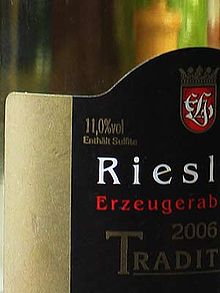Sulfite
Sulphites are the salts and esters of the sulphurous acid H2SO3. The salts contain sulfite ion (SO32-) as an anion. They are often used as preservatives in wine, dried fruit and potato products. However, sulfites also occur naturally in almost all wines.
Also called sulfites are the esters of sulfurous acid with the general formula R-O-S(=O)-O-R′ (with R and R′ as organic radicals).
The sulfurous acid is a biprotonic acid. Therefore exist among the salts the
- sulphites (MI2SO3), also known as normal, neutral or secondary sulphites, and
- Hydrogen sulphites (MIHSO3), also called primary or acid sulphites or bisulphites.
Hydrogen sulfites do not exist as solid salts and are only present in aqueous solutions. When a solution is concentrated, hydrogen sulphites react to form disulphites (S2O52-) by splitting off water and forming a sulphur-sulphur bond:
Under acidic conditions, sulfites and hydrogen sulfites release sulfur dioxide:

Sulfite anion
Usage
Sulphites are used as reducing agents. The hydrogen sulfite anion reacts in chemical reactions as a nucleophile (e.g.: with aldehydes to form well-crystallizing salts). Important processes for the production of pulp and paper from wood work with sulphites, see sulphite processes (among others calcium hydrogen sulphite, according to Mitscherlich).
Sulphites in wine
The labelling "contains sulphites" or "contains sulphur dioxide" is obligatory according to Art. 3 (3) of the Wine Market Organisation Implementing Regulation for concentrations of more than 10 mg/l. In the USA, wines bottled after mid-1987 must contain a reference to sulphites on the label. The corresponding regulation in the EU has been in force since 2005. The labelling obligation is due to the fact that people with a hypersensitivity to sulphites show intolerance reactions such as bronchospasms and asthma, anaphylactoid reactions, urticaria and low blood pressure when consuming even small amounts of sulphite.
Sulphites are formed naturally in small quantities (10-30 mg/l) during the alcoholic fermentation of the wine. Since the end of the 18th century, the antimicrobial as well as the antioxidant effect of sulphur has been known. Since that time, the addition of sulfur has been firmly established in winemaking worldwide. Amounts of sulphur dioxide between 90 and 400 mg/l are used in wine. Sulphur dioxide (SO2) is added to wine in gaseous form, in aqueous solution, as "sulphur powder" (potassium disulphite), in the form of tablets or, as in the past, by burning out barrels with sulphur chips.
Sulphites make it possible to store wines for a longer period of time without the wines "turning over" completely due to oxidation, i.e. enjoyment is only possible to a limited extent or not at all. In addition, they prevent undesired secondary fermentation in the bottled wine, as they effectively prevent microorganisms (such as yeasts) from doing their work.
The addition of sulphites is also permitted in wines from organic cultivation and must also be labelled on the bottle.
In some places, there are efforts within the wine industry to produce wines without the addition of sulfur dioxide. For some years now, some conventional as well as organic wineries have been successful in doing so, which is mainly due to modern wine press technology.
There are maximum limits for sulphur dioxide in wine according to the EC Regulation.
| Type of wine | EC maximum limit SO2 total |
| Red wine < 5 g/l residual sugar | 150 mg/l (until 31 July 2009: 160 mg/l) |
| Red wine > 5 g/l residual sugar | 200 mg/l (until 31 July 2009: 210 mg/l) |
| White wine & rosé wine < 5 g/l residual sugar | 200 mg/l (until 31 July 2009: 210 mg/l) |
| White wine & rosé wine > 5 g/l residual sugar | 250 mg/l (until 31 July 2009: 260 mg/l) |
| Spätlese and comparable foreign wines | 300 mg/l |
| Auslese and comparable foreign wines | 350 mg/l |
| Beerenauslese and Trockenbeerenauslese, ice wine and comparable foreign wines | 400 mg/l |
| Wines with the indication "suitable for diabetics" (no longer permitted since 1 July 2007) | 150 mg/l |
DNA methylation
Bisulfites can react selectively with cytosines in DNA. This is used in bisulfite sequencing to determine methylated DNA.

Marking: Contains sulfites
Detection
The qualitative detection can be done indirectly with permanganates. These decolorize in a redox reaction if sulfites are present.
Sulphite ions react with permanganate ions in an acidic environment to form manganese(II) ions, sulphate ions and water.
The reaction is not specific for sulphites and can therefore only be used as a detection for sulphites when the presence of other reducing agents is excluded. Similarly, an iodine solution is decolorized from sulfites, reducing iodine to iodide and oxidizing sulfite to sulfate.
With nitroprusside sodium, a red precipitate of Zn2[Fe(CN)5SO3] is formed in the presence of zinc ions. With barium chloride solution a white precipitate of barium sulphite is formed which, unlike barium sulphate, is readily soluble in acids.
Search within the encyclopedia
![{\mathrm {2\ HSO_{3}^{-}\ \rightleftharpoons \ [O_{2}S{-}SO_{3}]^{{2-}}+H_{2}O}}](https://www.alegsaonline.com/image/36494f459b9058c12aa7344a18ea3ce5d8c7cb5e.svg)
